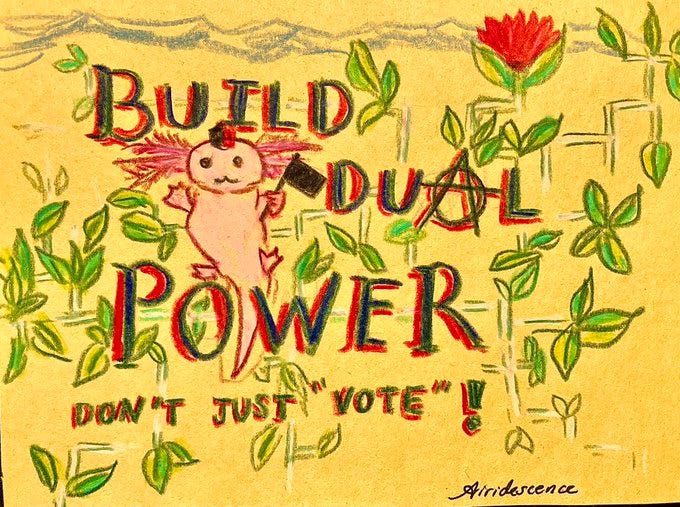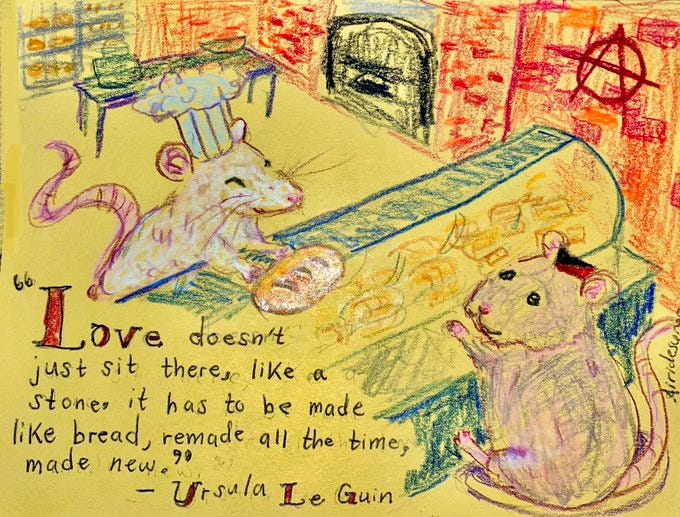Beyond the Ballot Box: Build Dual Power for Real Change
Empower People Through Mutual Aid, Solidarity, and Community Control.
“Build Dual Power. Don’t Just “Vote”! - Art by @Airidescence
In a world where elections often fail to represent the interests of ordinary people, we’re left searching for alternatives—ways to shape the future without waiting for top-down solutions. This is where the concept of dual power comes in.
Rooted in revolutionary thought, dual power is about building structures that serve communities directly, bypassing the authority of traditional power systems. It’s not about small adjustments or gradual reforms; it’s about creating the foundation of a new society, one that prioritizes mutual aid, collective action, and the needs of the many over the few.
What is Dual Power?
Art by @Airidescence
“Love doesn’t just sit there, like a stone, it has to be made like bread, remade all the time, made new.”
- Ursula Le Guin
Dual power seeks to do more than improve the existing system. Instead, it builds alternatives that function independently, challenging the dominance of centralized power. By constructing institutions that exist outside of and parallel to the state, we can work toward something transformative—systems that don’t rely on the government’s permission or corporate backing to meet people’s needs.
At the core of dual power are mutual aid networks—people coming together to care for one another without bureaucratic barriers or reliance on charity. A community fridge, a health clinic, or a network for sharing food and clothing might seem like small acts, but they have powerful implications.
Each of these initiatives creates a support system that reduces dependency on profit-driven corporations and unreliable government assistance. Mutual aid emphasizes solidarity and making decisions by consensus. It fosters a deep sense of community care, showing that we can sustain each other.
Communities Share Resources Locally
Art by @Airidescence
Economic independence is another critical pillar. Dual power envisions a world where people aren’t beholden to exploitative work or corporate hierarchies. In a cooperative business, workers have a direct say in decisions, ownership, and profits, eliminating the need for a distant CEO to decide what happens in a local community.
When communities establish worker-owned enterprises, they ensure that resources stay within the community, circulating locally rather than funneling upward. Over time, a web of cooperatives and community-owned businesses can build a stable foundation that undercuts the need for traditional capitalist structures.
Grow and Trade Food
Art by @Airidescence
Food sovereignty is also central. In a society increasingly dependent on industrialized, profit-driven agriculture, building local food systems offers resilience and empowerment. Through community gardens, farmers’ markets, and food cooperatives, people can reclaim control over what they eat.
It’s a direct way to challenge the exploitative practices of large agribusinesses and, simultaneously, reconnect with the land and each other. Food sovereignty isn’t just about access; it’s about independence—about the ability to sustain ourselves without relying on corporations that prioritize profit over the well-being of people and the environment.
Protect One Another
Art by @Airidescence
Dual power requires community defense as well. Safety and security should come from within communities, based on trust, accountability, and care, rather than through external forces that may not share the community’s best interests. Community defense initiatives like Copwatch, de-escalation training, or harm reduction programs provide frameworks that support people directly.
When neighbors look out for each other, we reduce dependence on police forces or institutions that may cause more harm than good. This kind of safety doesn’t prioritize punishment; it centers on protection, creating a foundation for genuine security and well-being.
Learn, Mentor, & Teach
Art by @Airidescence
“Liberty is a feature not of isolation but of interaction, not of exclusion but rather of connection.”
- Murray Bookchin
Education and skill-sharing play a unique role in this framework. Skill-sharing workshops, coworking, informal classes, and knowledge exchanges empower individuals to take control of their lives without relying on external authorities. Community education offers a powerful alternative to traditional schooling, which often emphasizes individual success over collective resilience.
In a dual-power model, learning becomes a community endeavor, emphasizing practical skills like first aid, organizing, building, and conflict resolution—skills that directly support self-sufficiency and resilience.
Final Thoughts
Art by @Airidescence
Of course, building dual power isn’t without challenges. Many of these structures operate with limited resources or under the threat of repression, but they persist. When communities come together, united by a shared vision, they become resilient. By networking with other dual-power groups, they build a solidarity that goes beyond any single effort, forming a web of mutual support that strengthens the whole.
Dual power is about creating alternatives that, piece by piece, replace the structures that currently control us. It’s a gradual process, yes, but every community-led effort, every new cooperative, and every mutual aid initiative is a step toward a future where people have the power to shape their lives. It may not always be flashy or headline-worthy, but in its quiet, determined way, dual power is revolutionary—it’s the work of building the world we want, from the ground up.
Featured radical art by
Please support them via Patreon or Venmo.Art by @Airidescence
Beyond Darwinism - Mutual Aid Index
Beyond Survival of the Fittest: Kropotkin's Vision of Mutual Aid
What is the role of solidarity and reciprocity in building equitable and sustainable communities?
Mutual Aid Among Plants and Animals: Cooperating for Survival
Peter Kropotkin Observes How Cooperation Among Species Improves Survival and Shapes Evolution.
Frolics and Barn-Raisings: Mutual Aid Amongst the Amish
Take a Look at the Amish Traditions of Collective Action and Solidarity.
The Arab Spring: Mutual Aid in the Fight for Freedom
See Solidarity in Action with the Collective Struggle for Liberation in the Arab Spring Movements.
The Black Panther Party’s Legacy of Community Empowerment Through Mutual Aid
The BPP protected and served their communities despite rampant racism and being the main targets of the FBI’s Counter-Intelligence Program.
Blessing Boxes: Mutual Aid in Our Communities Today
Find Out How These Simple Free Community Pantries Transform Neighborhoods and Promote Solidarity.
Childcare Collectives: A Modern Expression of Mutual Aid
Childcare Collectives develop when families, friends, and neighbors pool their resources to raise children.
Feeding Hope: The Impact of Community Fridges as Mutual Aid
See How Grassroots Efforts Like Chattanooga’s Hope Community Fridge Transforms Food Access and Fights Food Apartheid.
Grow Food Together: The Impact of Community Gardening as Mutual Aid
Shared Gardens Enhance Food Security, Build Community Bonds, and Promote Well-being Without Personal Expense.
Community Self-Defense: Protecting Ourselves and One Another
Let’s Talk About How Communities Work Together to Protect Themselves From Harm Inflicted by the State and Fascists.
Community Workspaces: Where Coworking Meets Opportunity
Find Out How Shared Community Workspaces Support Creativity and Mutual Empowerment.
Deciding Together: The Consensus Model in Mutual Aid
How Collective Decision-Making Builds Strong and Resilient Movements As Shown by Occupy Wall Street.
Live Together, Thrive Together: Shared Housing as Mutual Aid
Imagine Housing as a Way to Build Community and Share Resources.
Breaking Bread, Building Bonds: What’s Cooking in Community Kitchens?
Learn How These Shared Kitchens Create Lasting Change Through Healthy Meals, Cooking Education, and Mutual Aid.
Migration and Mutual Aid: Navigating a Climate Crisis Together
The USA and Global North Grew Rich Burning Fossil Fuels. Radical Cooperation Can Help Us Adapt to a Changing World.
Forgive Us Our Debts: How Debt Collective Helps Abolish Financial Servitude
Debt Collective Branched Off From Occupy Wall Street and Unifies Debtors in Mutual Aid for Collective Liberation.
Thou Doth Protest? How The Diggers Reclaimed the Commons and Fought Early Capitalism
Learn About the Radical Solidarity and Resistance to the Enclosure of the Common Lands in 17th-Century England.
A World Without Barriers: Consider Accessibility in Mutual Aid
Everyone Becomes Disabled if They Are Lucky. So How Can We Make Our World More Accessible?
Mutual Aid in the Eye of the Storm: Disaster Relief Amid Climate Change
When Disaster Strikes, Mutual Aid Responds: A Blueprint for Resilience Amid More Frequent Catastrophes
Beyond the Ballot Box: Build Dual Power for Real Change
Empower People Through Mutual Aid, Solidarity, and Community Control.
Communities of Care: How Solidarity Transforms Support for Elders and the Differently-Abled
How Can Mutual Aid Principles Change Elderly and Disabled Care From Isolation to Connection?
Growing Resistance: How Food Forests Feed Communities for Free and Defy Capitalism
From Commodities to Commons: The Radical Potential of Agroforestry
Roots of Resilience: Black Mutual Aid Societies in American History
Explore W.E.B. Du Bois’ Work and the Heritage of Solidarity Among Black Folk.
From Despair to Dignity: The Radical Work of Free Clinics
How Mutual Aid and Community Solidarity Transform Access to Healthcare
Feeding Each Other: The Radical Power of Free Grocery Stores
How This Kind of Mutual Aid Transforms Hunger Relief into Community Empowerment
Challenge Capitalism One Free Store at a Time
How Free Stores Empower Communities and Challenge Scarcity
The Past & Future of Self-Governance: How General Assemblies Build Dual Power
Strengthen Communities Through Direct Democracy and Mutual Aid
Let Joy Guide You: The Power of Fun in Change Work
Explore the Role of Laughter, Creativity, and Connection in Community Organizing
Fascism Unmasked: How to Recognize and Resist Modern Authoritarianism
Empower Your Resistance: A Practical Guide to Revolutionary Optimism, Mutual Aid, and Defying Totalitarians
Resist Burnout: Care, Coping, and Wellness in Dark Times
How can we practice self-care to endure the revolutionary marathon and better support one another?
Resistance Anthems: Protest Music for Hard Times
Let’s Unite Our Voices For Justice Through the Power of Music!
Affinity Groups: Decentralized Resistance in an Age of Crises
How Do Small, Autonomous Collectives Build Power and Resistance Against Fascism, Capitalism, and Collapse?
Share a Feast: How Potlucks Build Community and Connection
Let’s Discuss How Sharing Food Nourishes Both Bodies and Bonds Across Generations.
Notes From the Underground: How Forests Teach Mutual Aid
How Do Fungi, Trees, and Other Plants Thrive Through Cooperation and Reciprocity?
Fight Book Bans with Little Free Libraries
How Do Little Free Libraries Turn the Tide Against Book Bans and Censorship?
Read, Rest, Revolt, Repeat: Study Groups as Mutual Aid
How Does Collective Study Build Power, Sharpen Strategy, and Sustain Movements?
Burn After Reading: Comms Discipline for Mutual Aid and Resistance
Think About Encryption, VPNs, Walkie-Talkies, and the Lost Art of Keeping Your Mouth Shut.












Great post. 🙏🏻☮️
It seems like cohousing fits in with this concept of dual power!